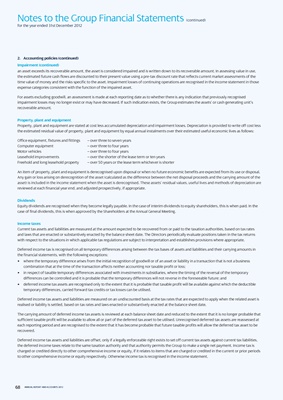
Notes to the Group Financial Statements (continued)
for the year ended 31st December 2012
2. Accounting policies (continued)
impairment (continued)
an asset exceeds its recoverable amount, the asset is considered impaired and is written down to its recoverable amount. In assessing value in use,
the estimated future cash flows are discounted to their present value using a pre-tax discount rate that reflects current market assessments of the
time value of money and the risks specific to the asset. Impairment losses of continuing operations are recognised in the income statement in those
expense categories consistent with the function of the impaired asset.
For assets excluding goodwill, an assessment is made at each reporting date as to whether there is any indication that previously recognised
impairment losses may no longer exist or may have decreased. If such indication exists, the Group estimates the assets’ or cash generating unit’s
recoverable amount.
Property, plant and equipment
Property, plant and equipment are stated at cost less accumulated depreciation and impairment losses. Depreciation is provided to write off cost less
the estimated residual value of property, plant and equipment by equal annual instalments over their estimated useful economic lives as follows:
Office equipment, fixtures and fittings – over three to seven years
Computer equipment – over three to four years
Motor vehicles – over three to four years
Leasehold improvements – over the shorter of the lease term or ten years
Freehold and long leasehold property – over 50 years or the lease term whichever is shorter
An item of property, plant and equipment is derecognised upon disposal or when no future economic benefits are expected from its use or disposal.
Any gain or loss arising on derecognition of the asset (calculated as the difference between the net disposal proceeds and the carrying amount of the
asset) is included in the income statement when the asset is derecognised. These assets’ residual values, useful lives and methods of depreciation are
reviewed at each financial year end, and adjusted prospectively, if appropriate.
Dividends
Equity dividends are recognised when they become legally payable. In the case of interim dividends to equity shareholders, this is when paid. In the
case of final dividends, this is when approved by the Shareholders at the Annual General Meeting.
income taxes
Current tax assets and liabilities are measured at the amount expected to be recovered from or paid to the taxation authorities, based on tax rates
and laws that are enacted or substantively enacted by the balance sheet date. The Directors periodically evaluate positions taken in the tax returns
with respect to the situations in which applicable tax regulations are subject to interpretation and establishes provisions where appropriate.
Deferred income tax is recognised on all temporary differences arising between the tax bases of assets and liabilities and their carrying amounts in
the financial statements, with the following exceptions:
• where the temporary difference arises from the initial recognition of goodwill or of an asset or liability in a transaction that is not a business
combination that at the time of the transaction affects neither accounting nor taxable profit or loss;
• in respect of taxable temporary differences associated with investments in subsidiaries, where the timing of the reversal of the temporary
differences can be controlled and it is probable that the temporary differences will not reverse in the foreseeable future; and
• deferred income tax assets are recognised only to the extent that it is probable that taxable profit will be available against which the deductible
temporary differences, carried forward tax credits or tax losses can be utilised.
Deferred income tax assets and liabilities are measured on an undiscounted basis at the tax rates that are expected to apply when the related asset is
realised or liability is settled, based on tax rates and laws enacted or substantively enacted at the balance sheet date.
The carrying amount of deferred income tax assets is reviewed at each balance sheet date and reduced to the extent that it is no longer probable that
sufficient taxable profit will be available to allow all or part of the deferred tax asset to be utilised. Unrecognised deferred tax assets are reassessed at
each reporting period and are recognised to the extent that it has become probable that future taxable profits will allow the deferred tax asset to be
recovered.
Deferred income tax assets and liabilities are offset, only if a legally enforceable right exists to set off current tax assets against current tax liabilities,
the deferred income taxes relate to the same taxation authority and that authority permits the Group to make a single net payment. Income tax is
charged or credited directly to other comprehensive income or equity, if it relates to items that are charged or credited in the current or prior periods
to other comprehensive income or equity respectively. Otherwise income tax is recognised in the income statement.
68 ANNUAL REPORT AND ACCOUNTS 2012